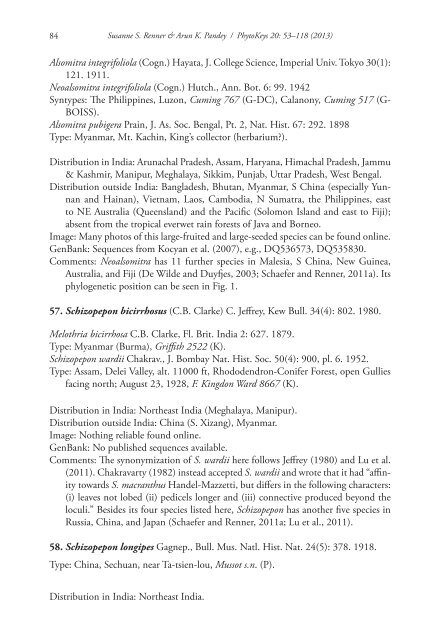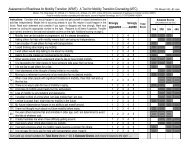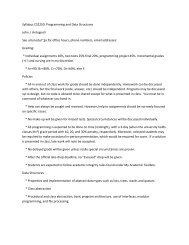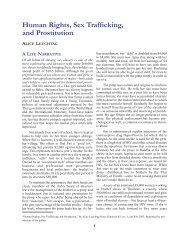The Cucurbitaceae of India: Accepted names, synonyms ...
The Cucurbitaceae of India: Accepted names, synonyms ...
The Cucurbitaceae of India: Accepted names, synonyms ...
You also want an ePaper? Increase the reach of your titles
YUMPU automatically turns print PDFs into web optimized ePapers that Google loves.
84<br />
Susanne S. Renner & Arun K. Pandey / PhytoKeys 20: 53–118 (2013)<br />
Alsomitra integrifoliola (Cogn.) Hayata, J. College Science, Imperial Univ. Tokyo 30(1):<br />
121. 1911.<br />
Neoalsomitra integrifoliola (Cogn.) Hutch., Ann. Bot. 6: 99. 1942<br />
Syntypes: <strong>The</strong> Philippines, Luzon, Cuming 767 (G-DC), Calanony, Cuming 517 (G-<br />
BOISS).<br />
Alsomitra pubigera Prain, J. As. Soc. Bengal, Pt. 2, Nat. Hist. 67: 292. 1898<br />
Type: Myanmar, Mt. Kachin, King’s collector (herbarium?).<br />
Distribution in <strong>India</strong>: Arunachal Pradesh, Assam, Haryana, Himachal Pradesh, Jammu<br />
& Kashmir, Manipur, Meghalaya, Sikkim, Punjab, Uttar Pradesh, West Bengal.<br />
Distribution outside <strong>India</strong>: Bangladesh, Bhutan, Myanmar, S China (especially Yunnan<br />
and Hainan), Vietnam, Laos, Cambodia, N Sumatra, the Philippines, east<br />
to NE Australia (Queensland) and the Pacific (Solomon Island and east to Fiji);<br />
absent from the tropical everwet rain forests <strong>of</strong> Java and Borneo.<br />
Image: Many photos <strong>of</strong> this large-fruited and large-seeded species can be found online.<br />
GenBank: Sequences from Kocyan et al. (2007), e.g., DQ536573, DQ535830.<br />
Comments: Neoalsomitra has 11 further species in Malesia, S China, New Guinea,<br />
Australia, and Fiji (De Wilde and Duyfjes, 2003; Schaefer and Renner, 2011a). Its<br />
phylogenetic position can be seen in Fig. 1.<br />
57. Schizopepon bicirrhosus (C.B. Clarke) C. Jeffrey, Kew Bull. 34(4): 802. 1980.<br />
Melothria bicirrhosa C.B. Clarke, Fl. Brit. <strong>India</strong> 2: 627. 1879.<br />
Type: Myanmar (Burma), Griffith 2522 (K).<br />
Schizopepon wardii Chakrav., J. Bombay Nat. Hist. Soc. 50(4): 900, pl. 6. 1952.<br />
Type: Assam, Delei Valley, alt. 11000 ft, Rhododendron-Conifer Forest, open Gullies<br />
facing north; August 23, 1928, F. Kingdon Ward 8667 (K).<br />
Distribution in <strong>India</strong>: Northeast <strong>India</strong> (Meghalaya, Manipur).<br />
Distribution outside <strong>India</strong>: China (S. Xizang), Myanmar.<br />
Image: Nothing reliable found online.<br />
GenBank: No published sequences available.<br />
Comments: <strong>The</strong> synonymization <strong>of</strong> S. wardii here follows Jeffrey (1980) and Lu et al.<br />
(2011). Chakravarty (1982) instead accepted S. wardii and wrote that it had “affinity<br />
towards S. macranthus Handel-Mazzetti, but differs in the following characters:<br />
(i) leaves not lobed (ii) pedicels longer and (iii) connective produced beyond the<br />
loculi.” Besides its four species listed here, Schizopepon has another five species in<br />
Russia, China, and Japan (Schaefer and Renner, 2011a; Lu et al., 2011).<br />
58. Schizopepon longipes Gagnep., Bull. Mus. Natl. Hist. Nat. 24(5): 378. 1918.<br />
Type: China, Sechuan, near Ta-tsien-lou, Mussot s.n. (P).<br />
Distribution in <strong>India</strong>: Northeast <strong>India</strong>.
















